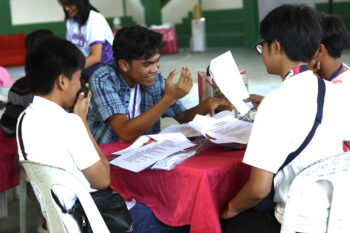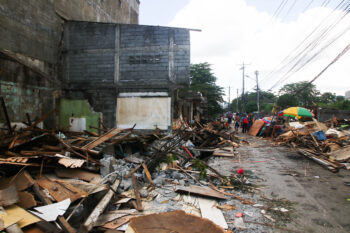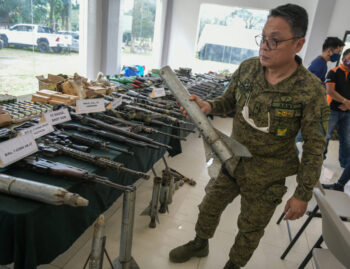
CEBU CITY (MindaNews / 27 October) – Another sad news reached the People of God across Mindanao in the evening of October 26, announcing the death of Sr. Esper Clapano M.A. The shocking news brought sadness to all those who have known Sr. Esper in the past decades, especially those active in justice and peace work. As with previous death announcements, when I got a barrage of messages via the FB Messenger about her death, flashes of memories returned to my mind.
I remember the first time I met her which I can still remember in detail after the passage of half a century. I had just returned to Davao City after a four-year stay in Manila where I studied at the Asian Social Institute. This was 1974 and the abuses of the military under martial rule was heightening. One incident that appalled the Church sector in the city was the military raid of the Religious of the Good Shepherd’s convent in Matina. Their chapel got desecrated in the process of the military’s forced inspection of their convent.
A quick response from the Church sector was to gather priests, religious and laypeople at the Cursillo House to hear the Sisters’ reports of what took place and to discuss how they could protest this violation of sacred space supposedly enjoyed by religious houses. I heard about the meeting from my friend, Fr. Roger Antalan, then executive secretary of the Mindanao-Sulu Pastoral Conference who brought me along to the forum.
The conference hall was jampacked with a hundred participants when we arrived at the venue and it immediately began as soon as we were seated. Sr. Regina Pil, the RGS local superior gave the report of the incident. One of those who responded during the open forum was Sr. Esper and that was my first sight of her. She did make a great first impression as I was struck how courageous this religious woman was in the manner she spoke against the military. From that day and in the next five decades, I would constantly be in touch with her.
In the long period of time that I have encountered many religious women across Mindanao, Sr. Esper would easily stand out as one of the most audacious in the manner she took on a prophetic stance on human rights and justice and peace issues. She was fearless in her anti-martial law engagements, oftentimes seen in the streets during rallies protesting human rights violations. However, she was always very kind to her adversaries – whether conservative bishops who hardly cared about social justice and the military she would encounter during rallies.
She was not a stranger to all kinds of conflicts both in and outside the Church. At the height of martial rule, internal tensions arose among the members of the Daughters of Mary of the Assumption. (Its acronym is FMA from its original French name.) The FMA Sisters, originally from Canada, arrived in the Archdiocese of Davao when the Archbishop was the Canadian PME priest, Archbishop Thibault. In the years that followed after their arrival in the 1950s, they established schools in the Prelature (later Diocese) of Tagum. In a matter of a few decades, local vocations flourished and soon there were more Filipina than Canadian FMA Sisters.
As the martial rule created fragmentations among the various institutions, this also led to tensions among members of families, network of friends and church institutions including religious congregations. Some FMA members felt that it had become difficult to agree on how they would respond to the worsening martial law situation. One faction felt they should become even more valorous in their resistance to martial law and take on a more public presence in the protest movement. They also critiqued the manner of their formation, governance, and other aspects of religious life.
Despite attempts at reconciling their differences through dialogue sessions, there came a point when they could not meet half-way as the more progressive faction believed they could not compromise their prophetic stance. So they began to strategize on how to separate from the FMAs and set up their own congregation which they named Missionaries of the Assumption, still retaining the Assumption name. It was on April 1, 1989 that they were formally organized. Archbishop Antonio Mabutas was considerate enough to support them in their quest to set up a local congregation. Sr. Esper, who served as one of the articulate leaders of this faction, became one of the founders of the Missionaries of the Assumption.
After their founding, the M.A. Sisters became even known to be one of the most progressive women religious congregations in the city and across Mindanao. Their flagship school – the Assumption College – then became known as a Catholic School who took seriously their Education for Justice thrust. From among their students, many young activists arose who joined the various NGOs in the city involved in the various urgent social issues. Sr. Esper was one of the faces of the women religious who served as model for new formands joining congregations.
During my stint as MSPC executive secretary, Sr. Esper (like Sr. Regina Pil RGS) was our avid supporter. She was constantly present in many of our conferences and meetings and helped to rally women religious towards the main thrust of MSPC, namely building Basic Ecclesial Communities that helped to conscientize the people as well as led to the organizing of the basic sectors. It was a time for networks that would engage in solidarity work with the poor, deprived and oppressed.
One network that got formally organized was the Sisters’ Association in Mindanao (SAMIN). In 1983, in their All-Sisters Mindanao Congress, the SAMIN members drafted their Constitution. The backdrop of this Congress was the engagement of the Sisters that brought the Church close to the people as they witnessed different forms of injustices and discrimination against the impoverished sectors of our society. For them, to make a preferential option for the poor was not just a calling but a responsibility to take seriously.
When asked in one interview what SAMIN was all about, Sr. Esper who served as chair of SAMIN recalled that its birth rode on the winds of change sweeping across the country at the tailend of the Marcos dictatorship. SAMIN was their response to the challenges of Vatican II, which called on the People of God to be a Church for the poor. Forty years later, SAMIN remains the main organization that inspires women religious to remain ensconced among marginalized groups through programs for women, children, indigenous people and urban poor communities. Others are also engaged in inter-religious dialogue even as many remain in traditional ministries such as schools, hospitals and charitable institutions.
As she became more intensely engaged in her justice and peace work, Sr. Esper realized she needed the energy to sustain her engagements. She needed another form of spirituality as the traditional spirituality to which women religious were accustomed to was no longer sufficient to sustain her in the difficult work she was engaged in. She began to search for a spirituality that would supplement what she was already practicing as an M.A. Sister.
Meanwhile, a Zen Center was set up in Manila, In 1976, Sr. Elaine MacInnes of the religious community Our Lady’s Missionaries (OLM) arrived in Manila and brought zen to those interested in this practice. She was assigned here after spending several years in Japan. Eventually she trained a few who showed interest and became her first followers. Sr. Esper heard about her and the Sanbo Kyodan Zen Center and eventually underwent the required sessions at this Center. After years of practicing Zen, Sr. Esper got appointed to the new batch of seniors and could serve as a Zen teacher. She helped finalize the criteria for membership in a Zen center and helped to formulate the criteria for the establishment of a new sangha (affiliate).
After being accredited as a Zen master, Sr. Esper convinced her Sisters that they could serve the needs of those seeking this spirituality by setting up their own Zen Center. It was then established as the M.A. Ashram Holistic Spirituality Institute located in Barangay Tacunan, outside the city center. After recruiting her followers, the Center’s members included full-time brothers and sisters and working partners. They began to practice Zen together and got engaged in interfaith dialogue. They also run Zen retreats for religious and lay people, either individually or in groups. In these retreats, the participants are introduced to the first steps in doing Zen and to do shibashi every morning. I had gone there myself for a retreat and found it exhilarating. Apart from this center, the Institute also set up a small retreat house in Maragusan in Davao de Oro.
Soon Sr. Esper became known as a Zen master and she trained a number of followers. Meanwhile, she sustained her commitment to justice and peace and became even more concerned about the plight of women and children. She also became a staunch advocate to protect the environment. She became more interested in studying eco-feminism. And this perspective began to be included in her retreats at the Zen Center. She strongly promoted healthy lifestyles in matters related to choices of food by becoming a vegetarian. She also supported community-based health projects that would popularize the use of herbal medicine highlighting the importance of the Oriental manner of maintaining good health.
As age was catching up with her, Sr. Esper needed to slow down. In the last year of her life, she had to cut down on outside engagements and lived the life of a hermit in their Center in Tacunan. Eventually, early signs of Alzheimers caught up with her. Her health deteriorated. In the morning of October 26, after taking a shower, she ate her breakfast. While eating, she complained to another sister that she felt very cold. Her lips turned dark. The sisters decided to rush her to Davao Doctors Hospital. By 8:00 in the evening, she passed away.
When we hear that someone just died, something dies in us, too. What is it about death that makes us – all of a sudden – somber and sad? And the grief can be so deep that it becomes extremely difficult to comfort those who experience the death of a loved one, especially if it happens so suddenly. No words are good enough to assuage the pain so that sometimes the best manner to comfort the bereaved is just to sit beside them and keep silent. Even if we are believers in the Lord’s promise of an afterlife in God’s Reign, we can’t expect a sense of rejoicing now that the soul is in God’s embrace! William Penn, the English writer who was a Quaker wrote: “For death is no more than a turning us over from time to eternity.” But these are just words that cannot comfort the bereaved.
Perhaps, this is where returning to our indigenous roots can help assuage the grief. Our ancestors believed – and today’s indigenous communities have held on to this belief – that while the bodies may no longer be physically present among us, their spirits remain among us for they never really move away. And that is why there is a lot of chanting, dancing and feasting during the burial rituals among our indigenous ancestors. In the years to come the rituals continue to take place where a special place is reserved for the spirits of those who died.
We can also hold on to the words of the poet Kahlil Gibran: “For what is it to die but to stand naked in the wind and to melt into the sun? And when the earth shall claim your limbs, then shall you truly dance.” I am deeply comforted while imagining that Sr. Esper is dancing with the Lord of the Dance!
(MindaViews is the opinion section of MindaNews. Redemptorist Brother Karl Gaspar is Mindanao’s most prolific book author. Gaspar is also a Datu Bago 2018 awardee, the highest honor the Davao City government bestows on its constituents. He recently moved to his new assignment in Cebu City.)







